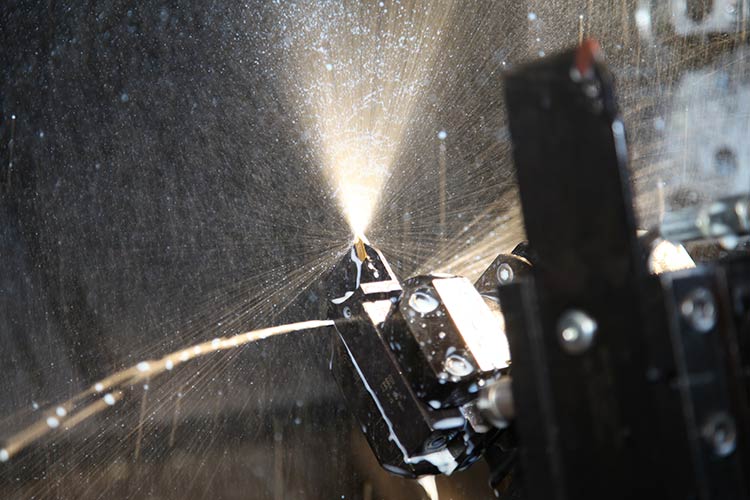The deeper the cuts and grooves, the greater the need for the effects of high-pressure coolant (HPC) to help ensure the increasingly essential combination of high performance, secure process and good quality parts. In today`s machining, productivity and reliability are the essentials for keeping production running smoothly. Parting and grooving are some of the more common operations, prone to operational risk, which can benefit greatly to the developments in HPC.
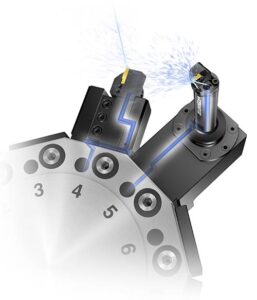 The challenges of applying….
The challenges of applying….
…. high-pressure coolant as a performance enhancer in parting and grooving operations can today be overcome by a number of technology developments. Newly developed tooling for this area provides accurately aimed nozzles for coolant jets to impact the right places and to penetrate into spaces and grooves where it can make a real difference to machining and thereby minimize risks.
Maintaining a parallel, laminar jet at pressure is critical once the coolant leaves the nozzle. The jet should have a positive effect on the contact length and shear-plane angle between chip and tool, have a cooling effect and to provide lubrication where it is needed. To achieve this, delivering the coolant at sufficiently high volume and pressure through all the machine, holder and tool interfaces has to be established with a minimum of involvement. Tool changing and coolant-supply connecting must not be time-consuming.
Parting and grooving operations ….
….is an area that presents typical challenges when applying high-pressure coolant to achieve potential benefits.
Satisfactory chip control, for instance, is vital to avoid unplanned stops or tool breakage. Especially parting operations with deeper cuts can give rise to long, stringy chips that can wrap around the tool and also get stuck in the chip conveyor, causing unplanned stops. If chips are
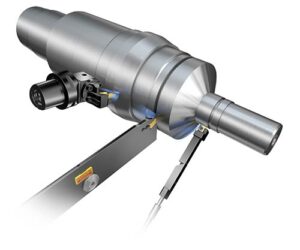
not properly formed and not shrunk in width, they can become stuck in the groove that the tool is cutting, causing not only excessively high load on the tool and thereby an unreliable process as well as poor surface finish.
Coolant as a lubricant is also essential in parting operations. It is generally not recommended to part off long chipping materials without the lubrication effect of a coolant. When the long, slender parting tool is fed deep into a workpiece, it is important to establish measures that enable sufficient coolant to reach the cutting zone, as an effective jet, where it is most needed. Even when good, traditional coolant setups have been used, most of the coolant will inevitably be blocked by the chip being formed. A coolant-jet is critical.
The HPC-coolant measure is also needed to help prevent built-up edges, especially when the cutting speed slows down towards the centre of cut in parting bar. This is when the machine reaches its spindle speed limit. In bar feed machines the bar-feeder equipment and the long bars require a lower spindle-speed limit than the machine itself. When cutting speed drops well below a recommended value, material welding to the cutting edge starts to take place in many materials and a built-up edge starts to form.
CoroCut QD ….
…. provides more and better possibilities for deep parting off operations, as well as deep grooves, with a newly developed inserts, rigid clamping, new tool-blade design and material and also efficient HPC-coolant supply. For manufacturers using bar-feed, process security in
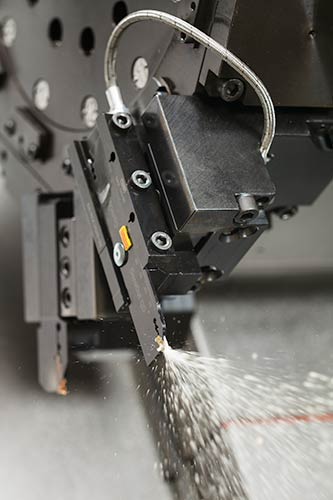
terms of good chip control and long reliable tool-life is critical to efficient production. To meet these needs CoroCut QD combines strong tools, inserts with rigid clamping and plug and play coolant supply.
Good chip control is further achieved by combining over-and-under-edge coolant supply. This keeps the temperature down at the cutting edge for less tool wear to develop and a more stable performance to be upheld, while at the same time providing efficient chip evacuation out of the groove. Rail insert seat ensures stable, precise insert position. This tool-system, with HPC facilities, has been developed for bar-feed machines with bar-diameters from 38 mm and larger and for sliding head machines with bar diameters above 32 mm.
A modern, deep-groove parting tool system today has to have a qualified high-precision coolant supply. It has to have high-technology nozzles providing high-pressure, laminar-jets of coolant precisely aimed in two directions : at the top on the chip-forming face of the insert and from the bottom along the clearance side to lubricate between tool and material. Inserts have a specially-developed channel as part of the geometry to further ensure that coolant and lubricant reaches the right place at the cutting edge and onto the chip forming part. Tools are connected to the coolant supply on the machine with dedicated adaptors to make it user-friendly and to avoid any need for tubes or hoses for the coolant connection. Parting blades can also be adjusted to achieve optimum tool-overhang with maintained correct coolant supply.
Coolant or lubricant is used in turning to minimize friction at the cutting edge, heat at tool and work-piece and tool-handling and set-up, but it is also to keep the machine clean and lubricated, prevent rust and transport chips. All CoroCut QD tools, being available with over and under coolant, can make use of the varying impact and advantage to suit different materials. Different coolant media, emulsion or oil will give different results : oil has a higher lubricating effect but the cooling effect is lower than emulsion.
On the smaller side of machining, ….
….CoroCut XS is a tangentially mounted system for precision machining in sliding-head machines. The system is used for external parting, grooving, turning, back-turning and threading applications where very sharp cutting edges perform best at low feeds. The benefits of the system includes high precision, easy indexing, wide a variety of insert widths, ideal for internal grooving at very small diameters – and available with modern application of high pressure coolant.
The QS-shanks can easily be connected to HPC in different ways : mounted in an adaptor, such as VDI or Coromant Capto. The QS adaptors and tools can be used with coolant pressures up to 150 bar, if needed to and if provided. Connections are available for the most common machine interfaces such as shank turrets, VDI star and face turrets, Coromant Capto, HSK-T. Machine-specific clamping units are available for different machine brand and type. A web-based tooling site : www.toolbuilder.sandvik.coromant.com makes it easy to find the right combination of adaptor and tool.
When it comes to face-grooving, high-pressure coolant has a clear, major positive effect on chip control and evacuation – this is when the pressure is in the region of 70 bar or more. Chip control/breaking is often a large problem to solve in face-grooving and HPC can often be a substantial problem solver in many common materials.
Over- or under supply of coolant – or a combination?
Depending on machining conditions, a choice can be made between using the through-tool coolant applied over or under the cutting edge. 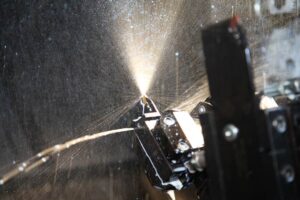 In many cases, a combination is the ideal. Over-coolant improves chip control, which is the key to long tool-life and fewer machine stoppages. Coolant from above also reduces build-up edge formation. Coolant applied from below reduces temperature from friction and the amount of flank wear as well as contributing to chip evacuation.
In many cases, a combination is the ideal. Over-coolant improves chip control, which is the key to long tool-life and fewer machine stoppages. Coolant from above also reduces build-up edge formation. Coolant applied from below reduces temperature from friction and the amount of flank wear as well as contributing to chip evacuation.
Reduced temperature in the cutting zone allows the use of softer, tougher insert grades with maintained and sometimes even increased tool-life and cutting data. It also provides the basis for more predictable tool-life and more secure machining process. Coolant from below is advantageous in long cuts, deep grooves, where temperature often is a negative factor.
Coolants applied at pressure have a varying impact depending on workpiece material. The effect from HPC is the greatest when machining materials with low thermal conductivity, such as some stainless steels, titanium and heat resistant super alloys. HPC also has a larger impact on smearing materials such as low carbon steels, aluminium and duplex stainless steels, where chip control is also an issue.
Conclusively, ….
…. the use of HPC as coolant and lubrication has a large impact on performance and process security in parting and grooving. If applied right, it reduces temperature at the cutting zone and improves chip evacuation. When external coolant is applied conventionally in parting and grooving, the amount of coolant that actually gets into the groove is very small, the effect is minor, this especially when machining deep grooves. With qualified, high-precision pressure-coolant application, coolant jets properly access the cutting edge even in deep grooves.
Advantages with modern through-tool HPC are typically :
- scope for higher cutting data or the use of tougher insert grade
- good chip control and consistent surface finish
- longer tool-life
- short, easy tool changing and set-up.
The application of HPC might involve some issues to consider but in modern machinery, 70 bar coolant pressure is usually standard or an option and provides the basis for making much better use of coolants through new technology as a serious performance improver. Thereby motivating the costs that coolant use involves.

